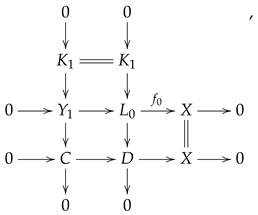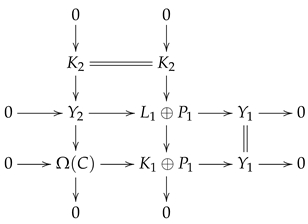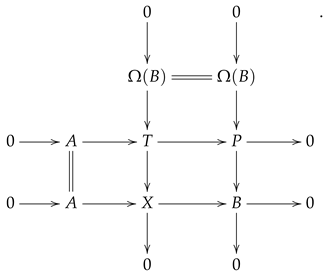1. Introduction
The representation dimension of an Artinian algebra was introduced by Auslander [
1], who showed that an Artinian algebra is representation finite precisely when its representation dimension is no greater than 2. And Iyama later [
2] showed that the representation dimensions of algebras are always finite. In [
3], Oppermann introduced the concept of the weak resolution dimensions of Artinian algebras, proving it is bounded above by the representation dimension minus two. Therefore, this invariant, analogous to the representation dimension, serves as a measure of the algebra’s deviation from representation finite algebras.
The weak resolution dimension has since been linked to other homological dimensions, such as the finitistic dimension, the extension dimension, and so on. The weak resolution dimension of an algebra always lies between its extension dimension and its finitistic dimension (see [
3,
4,
5] for details). And the Igusa–Todorov distance defined by Zhang and Zheng in [
6] is equal to the weak resolution dimension of a particular subcategory of modules over Artinian algebras. Moreover, several important classes of Artinian algebras, such as Igusa–Todorov algebras, can be characterized in terms of their weak resolution dimensions (see [
4,
5,
7,
8] for details).
This study focuses on investigating the relationships between the weak resolution dimensions of subcategories of module categories of Artinian algebras. Our main theorem is the following:
Theorem A (Theorem 1)
Suppose that , and are subcategories of , such that each object X in is given by an exact sequencewith , . Then,where stand for weak resolution dimensions of and respectively. As applications, we establish relationships between the weak resolution dimensions of Artinian algebras linked by left idealized extensions.
Theorem B (Theorem 3)
Let be a chain of Artinian algebras, where is a left idealized extension of , for all i. Then, The organization of this paper begins with preliminaries in
Section 2, followed by the proofs of Theorems A and B in
Section 3.
2. Preliminaries
In this study, unless otherwise specified, all rings are Artinian algebras over a commutative Artinian ring R, and all modules are finitely generated left modules. Given an Artinian algebra , denotes the category formed by all finitely generated left -modules. Let be a subcategory of ; we define as its closure under finite direct sums and direct summands. In case of , we write instead of . A -module X is said to be a generator-cogenerator for -modules, provided that and where is the standard duality. An Artinian algebra is em representation finite, provided there exists a -module X satisfying . The notation will stand for the projective dimension of a -module M.
The notions of weak resolution dimensions were introduced by Oppermann in ([
3], Definition 2.4).
Definition 1 ([
3], Definition 2.4).
Suppose that Λ
is an Artinian algebra, and A is a Λ
-module as follows: - (1)
We define the weak A-resolution dimension of a Λ-module Y as
; there exists an exact sequence with each
- (2)
For a subcategory of Λ-modules, the weak resolution dimension of is defined to be
Furthermore, the weak resolution dimension of is defined as Remark 1. Iyama in [9], Definition 4.5(2) also introduced the concept of the weak resolution dimension. Let Λ
be an Artinian algebra, and . The weak M-resolution dimension of a module introduced by Iyama, denoted by I. w. resol. dim (X), is defined as ; there is an exact sequence with each and It is easy to see that for Λ
-modules M and X. By the definition of the weak resolution dimension, the following result is directly applicable:
Lemma 1. Let be two subcategories of Λ-modules.
- (1)
if and only if there is a Λ-module Y with . This directly implies that Λ is finite representation precisely when
- (2)
, when .
- (3)
Let A and B be Λ
-modules with , then
Proof. Points (1) and (2) are clear hold, we prove only Point (3).
(3) Assume that
A-
. Then, for any
, we have a long exact sequence
with each
. It means
B-
as desired. □
For an Artinian algebra
,
the finitistic dimension (fin.dim
) is the supremum of the projective dimensions of
-modules, while we recall from [
1] that its
representation dimension (rep.dim
) is the infimum of the global dimensions of the endomorphism algebras of generator-cogenerators.
Lemma 2. Suppose that Λ is an Artinian algebra as follows:
- (1)
.
- (2)
If Λ is not semisimple, then .
Proof. (1) By the definition of the finitistic dimension of , we have fin.dim=. The assertion follows:
Point (2) follows [
3] (Remark 2.6). □
Let
be an Artinian algebra, and let
N be a
-module, and
m a positive integer. Recall that a
-module
X is said to be the
m-th syzygy module of
N, denoted by
, if there exists an exact sequence
with each
the projective cover of
. We used
to denote the subcategory of
whose objects are the
m-th syzygies of modules in
.
Lemma 3 ([
4], Lemma 2.8).
Suppose that the sequence of Λ
-module,is exact. Then, for any , we have the following exact sequence:in , where each is projective. The following lemma from Lemma 3 applies directly:
Lemma 4. Let be a subcategory of modules over an Artinian algnbra Λ
. Then, for any , 3. Main Results
Proposition 1. Assume that Λ
is an Artinian algebra and , and the sequence is exact in modΛ
. If there are exact sequenceswith each , andwith each . Then, we have an exact sequencewhere each . Proof. Set
, for any
Then,
and
. From the exact sequence (2), for each
, there exist short exact sequences
Consider the Pullback diagram
which is also a Pushout. We therefore derive a short exact sequence
and
Let be the projective cover of C. The Pullback diagram
gives an exact sequence
by the projective property of
.
From the exact sequence
we derive another exact sequence
By Pullback, there is a commutative exact diagram
Thus, one obtains two exact sequences
and
The combination of the exact sequences (4) and (7) produces the following exact sequence:
Proceeding inductively, we construct exact sequences
and
Let be the projective cover of . By Pullback,
one obtains a long exact sequence
since there is a
-module isomorphism
by the projective property of
.
Combining the exact sequences (9) and (10), we obtain a long exact sequence
Appealing to Lemma 3, one constructs the desired exact sequence. □
Theorem 1. Suppose that , and are subcategories of , such that each object X in is given by an exact sequencewith , . Then, Proof. Assume that, without loss of generality, , and
. Consequently, there exist -modules U and L such that and
For any object
X in
, by assumption, one has a short exact sequence
with
and
. By assumption, one obtains two long exact sequences
with each
, and
with each
.
Applying Proposition 1 to these sequences yields a new exact sequence
where
are projective, for all
Taking , then, we have Thus, the ineqation is proved by the above discussion. □
Remark 2. Let Λ be an Artinain algebra. Take , and . Then , and satisfy the condition of Theorem 1. Moreover, suppose that Λ is a torsionless-finite algebra, that is, is representation finite. Then
Corollary 1. Let , and be subcategories of , such that any object C in is given by a long exact sequencewhere , and each . Then we haveIn particular, if is representation finite, then Proof. Put and there exists an exact sequence , with and , for any . Then . Through inductive application of Theorem 1, one gets . And the first part of this assertion is obtained by Lemma 1.
In particular, if is representation finite. Due to Lemma 1, . Thus, □
Corollary 2. Let Λ
be an Artinian algebra. For any positive integer s, we have Proof. The existence, for any
, of an exact sequence
with each
ensures that
And the assertion follows from Corollary 1 in great detail. □
Let and be subcategories of . The class consists of those that admit an exact sequence , for some and .
Theorem 2. Let , and be subcategories of with . Then Proof. Assume that, without loss of generality, and
.
For any object
X in
, by assumption, one obtains a short exact sequence
where
and
. Letting
P be the projective cover of
B, the construction of the pullback then yields the following commutative exact diagram.
This induces the following exact sequence
by the split property of the second row.
The assumption that
guarantees the existence of a
-module
U with
U-
. Whence,
A admits a resolution
in which all
. Combining this with the projective module
P, we obtain an exact sequence
Noting that
, then, by Lemma 4, one has
. Whence, there exists a
-module
L satisfying
L-
, thereby providing an exact sequence in
:
in which each
.
The application of Proposition 1 to exact sequences (11), (12), and (13) gives a long exact sequence
The terms
for all
k, and
for all
i. Since
P is a projective
-module, all terms in sequence (14) belong to the additive subcategory
.
Setting , the long exact sequence (14) is a resolution of X by modules in . Therefore, we have . And the assertion follows. □
In the following, we give some application results above.
Let be a homomorphism of Artinian algebras, then we have a restriction functor: . For any subcategory of , is defined as the image of under the restricted functor. In particular, we use to denote the image of under the restricted functor.
Lemma 5. Let be a homomorphism of Artinian algebras. For any subcategory of Γ
-modules, we have Proof. Assume that, without loss of generality,
. Then there exists
with the property that for every
, there is an exact sequence in
:
in which each
.
Applying the restrict functor (which is exact) to the above sequence, This yields, for each
, an exact sequence in
:
with
This infers
□
Let
be a subalgebra of
such that
and
have the same identity. Following [
10], we say that
is
a left idealized extension of
when rad
is a left ideal of
. In the following, we will establish relationships between weak resolution dimensions of Artinian algebras linked by left idealized extensions. The following lemma is needed.
Lemma 6 ([
11], Lemma 0.1 and Lemma 0.2).
Let Γ
be a left idealized extension of an Artinian algebra Λ
. For a Λ
-module X and an integer , then we have and a Γ
-module isomorphism , where and . Theorem 3. Let be a chain of Artinian algebras, where is a left idealized extension of , for all i. Then Proof. By assumption and by Lemma 6, for any , we have and an -module isomorphism , for some projective -module and some -module .
Let
be the projective cover of
as a
-module. Then, there is an exact sequence in
:
which is also exact in
.
Proceeding inductively, we are led to an exact sequence in
:
with
and each
. By Lemma 6 again,
. So,
. The definition of syzygy modules yields an exact sequence in
:
where
and
are projective
-modules. Combining (15) and (16), one obtains a long exact sequence in
On the other hand, let
. Then, by Lemma 1,
. By Corollary 1 and Lemma 5, one has
□
The left representation distance of an Artinian algebra
, denoted
, is defined as the smallest
s for which one can construct a chain
by successively forming left idealized extensions (i.e.,
is a left idealized extension of
), until reaching a representation-finite algebra
. In the study of the finitistic dimension conjecture, Xi introduced the concept of left representation distances for Artinian algebras in [
12], p. 341 and established their finiteness. Building on this, we provide a bound for the weak resolution dimension of an Artinian algebra by its left representation distances.
Corollary 3. Assume that Λ is an Artinian algebra. Then, Proof. It follows from Theorem 3, combined with the fact that representation finite algebras have weak resolution dimension zero by Lemma 1.
□
We now present an example to illustrate Theorem 3.
Example 1. Let F be an algebraically closed field, and let Λ
be a finite-dimensional F-algebra defined by the quiver below:with relations: . And assume that and . Let Γ be a finite-dimensional F-algebra defined by the quiver below:
with relations.
Let Π be a finite-dimensional k-algebra given by the following quiver:
with relations .
By [5], Proposition 4.7, we obtain that Λ
is representation finite and that is a chain of left idealized extensions. It follows from Theorem 3 that and Theorem 4. Suppose that I and J are two ideals of Artinian algebra Γ
satisfying Then, Proof. Denote
, and
. We claim that
. Indeed, for any
, we take
P to be the projective cover of
X. Then
. Take
and
. We have an exact sequence in
,
By assumption,
. Then
is a
-module. We have
. On the other hand, noting that
, one has
. So,
. From the sequence (17), we have
and the claim is obtained.
Due to Theorem 2, it follows that . Therefore, by Corollary 2 and Lemma 5, one has as regards. □
Proposition 2. Assume that are ideals of an Artinian algebra Γ
such that , for each . Then Proof. Denote
, for each
, then
. For any
, we take the projective cover of
and denote
. Then, one obtains an exact sequence in
Since
,
Proceeding inductively, one has each
. Thus, we obtain the following exact sequence in
:
with
and each
.
Denote and . Clearly, is representative finite. By Lemma 5 and Corollary 1, we have as regard. □












